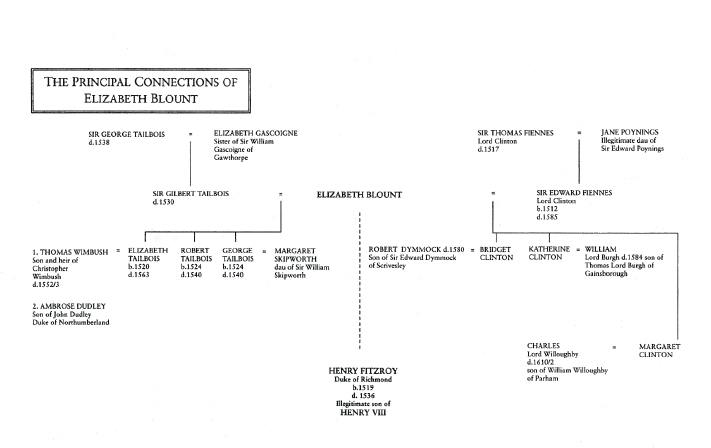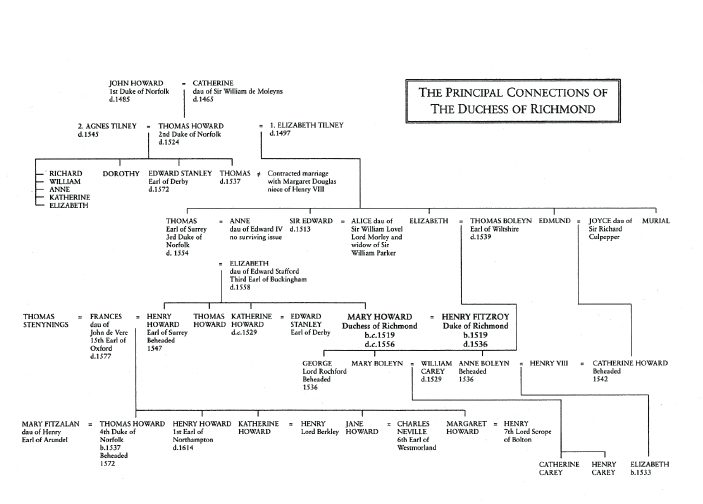Bastard Prince (38 page)



Preface
1. Â
Inventories of the Wardrobe Plate Chapel Stuff etc. of Henry Fitzroy, Duke of Richmond. . . . Edited with a Memoir and Letters of the Duke of Richmond
, ed. J.G. Nichols.
2.  E. Cherbury, Lord Herbert,
Life and Reign of King Henry the Eighth
, p. 165.
3.  E. Barnwell,
Perrot Notes
,
Some Account of the Various Branches of the Perrot Family
(1867), p. 40.
4.  D. Edwards,
The Edwardes Legacy
(Baltimore, 1992), p. 22.
5.  E. Ives,
Anne Boleyn
, p. 250.
6.  Writing in March 1997 Anthony Hoskins put forward a new theory which used revised ages for Henry and Catherine in an attempt to prove beyond any doubt that they were both Henry VIII's children. A. Hoskins, âMary Boleyn Carey's Children â Offspring of King Henry VIII',
Genealogist's Magazine
, 25 (1997), n.9.
7.  British Library (BL), Harleian MS 252, f. 26.
Chapter One
1.  Public Record Office (PRO), E36/215, f. 250.
2. Â
Letters and Papers, Foreign and Domestic, of the Reign of Henry VIII
, ed. J.S. Brewer et al., p. 395.
3.  For a full discussion of the problems Henry VII faced in securing his throne see S.B. Chimes,
Henry VII
(1987), pp. 68â94.
4. Â
Letters and Papers Illustrative of the Reigns of Richard III and Henry VII
, ed. J. Gairdner (2 vols, 1861, 1863), I, pp. 233â4.
5.  One of the points that does not seem to have been a particular problem was Archbishop Warham's concern over the validity of the six-year-old papal dispensation, which allowed for the fact that Katherine had had sexual intercourse with Arthur. D. Loades,
The Politics of Marriage
(Stroud, 1994), p .17.
6.  N. Samman, âThe Henrician Court During Cardinal Wolsey's Ascendancy
c
. 1514â1529' (unpublished Ph.D., University of Wales, 1988), p. 175.
7. Â
Calendar of Letters, Dispatches and State Papers (CSP) Relating to Negotiations between England and Spain 1485â1558
, ed. G.A. Bergenroth, et al. (1862â1954) Supplement, p. 285. G. Mattingly,
Catherine of Aragon
(1971), pp. 110â12. W. Compton,
History of the Comptons of Compton Wynyates
, p. 15.
8.  The Blounts of Kinlet were the descendants of Sir John Blount through his first marriage in 1347 to Isolda, the daughter and heir of Sir Thomas de Mountjoy. The Blounts, the Lords Mountjoy, were the descendants of his second marriage to Eleanor, the daughter of Lord Beauchamp of Somerset.
9.  PRO, E36/215, f. 270. A. Somerset,
Ladies in Waiting
, p. 15.
10.  Shropshire Record Office (SRO), 1878/3 29.
11.  SRO 1878/3 27.
12.  W.S. Childe-Pemberton,
Elizabeth Blount and Henry VIII
, p. 20.
13.  BL, Cotton MS Titus A XIII, f. 187.
14.  S.J. Gunn,
Charles Brandon, Duke of Suffolk,
c
. 1484â1545
, p. 6.
15.  BL, Additional MSS 28585, f. 43.
16.  The report came from the Imperial agent James Banisius and is not corroborated by any other source. David Loades is probably correct when he suggests that if there was a child it was âalmost certainly dead, and many weeks premature.' D. Loades,
The Politics of Marriage
, p. 24.
17.  BL, Cott. MS Caligula D VI, f. 155.
18.  In 1514 Charles Brandon had already contracted four marriages. He had put aside the first wife, Anne Browne, when she was pregnant with their daughter, so he could marry her aunt Margaret Mortimer, a wealthy heiress. He then had that marriage annulled in order to remarry Anne and, after her death, had made plans to marry his eight-year-old ward. Despite rumours of his interest in Margaret of Savoy, in 1515 he actually married the king's sister, Mary Tudor.
19.  Or to be exact âuna grandissima ribald et infame sopre tutte',
Letters and Papers
, X, 450. E. Ives,
Anne Boleyn
, p. 34.
20.  PRO, SP1/70, 61. SP1/10, 163.
21.  For what little is known of Jane Poppingcourt's career in England see Samman, âHenrician Court', p. 147. W. Richardson,
Mary Tudor, The White Queen
, p. 14.
22.  PRO, E36/215 f. 449.
23.  E. Hall,
Chronicle Containing the History of England
, ed. H. Ellis (1809), p. 703.
24.  Ibid., p. 595.
25.  Wolsey's two children by âMistress Lark' were a son, Thomas Winter, who received numerous clerical preferments and a daughter, Dorothy, who secured a place in the wealthy convent at Shaftesbury Abbey. P. Gwyn,
The King's Cardinal
(1990), p. 351.
26.  N. Samman, âHenrician Court', p. 403.
27.  G. Mattingly,
Catherine of Aragon
, p. 132.
28.  H.S. Burke,
Historical Portrait of the Tudor Dynasty
(4 vols, 1879â83), I, p. 178.
Letters and Papers
, III, ii, Revels Accounts, p. 1559.
29.  PRO, Durham 3, Portf. 177, p. 55.
30.  W.C. Richardson, âThe Surveyor of the King's Prerogative',
English Historical Review
, (1941), p. 60.
31.  Letters and Papers, III, ii, 2356. (18).
32.  R. Warnicke,
The Rise and Fall of Anne Boleyn
, p. 49.
33.  N. Samman, âHenrician Court,' p. 186.
34.  BL, Cott. Otho, CX, f. 234.
35.  PRO, SP1/55 15.
36.  PRO, SP1/55 14.
37. Â
Inventory of the Wardrobe of Henry Fitzroy, Duke of Richmond, 1531
[17], Historical Manuscript Commision, Longleat Miscellaneous Manuscripts (microfilm, reel 2) 97. The young Lord Tailbois would also receive other items of his half-brother's wardrobe in 1536. J.G. Nichols,
Inventories of the Wardrobe
, 1ff.
38.  Alice Perrers was the infamous mistress of Edward III whose influence was matched only by her ambition.
39.  E. Ives,
Anne Boleyn
, p. 20.
40.  14 & 15 Henry VIII. C.34.
41.  BL, Add. MSS 46457, f. 56 ff.
42. Â
Letters and Papers
, IV, iii, 5750.
Chapter Two
1.  S. Thurley,
The Royal Palaces of Tudor England
, p. 119.
2.  BL, Cott. MS Tiberius E.VIII, f. 206. The earls who were chosen to accompany Fitzroy during this part of the ceremony were those who ranked first in the order of precedence. See H. Miller,
Henry VIII and the English Nobility
, p. 20.
3.  BL, Egerton MS 2642, f. 7.
4.  Arthur Plantagenet, Viscount Lisle, the bastard son of Edward IV, acquired his title in the reign of Henry VIII, through his marriage to Elizabeth, the daughter of Edward Grey, Viscount Lisle.
5.  John Beaufort was the eldest son of four illegitimate children born to John of Gaunt and his mistress Katherine Swynford. As the product of an adulterous affair the children were not automatically legitimated when their parents married in 1399. However, when Gaunt successfully petitioned the Pope for a dispensation their legitimacy was confirmed. C. Given-Wilson and A. Curteis,
The Royal Bastards of Medieval England
, pp. 147â53.
6.  M. Jones and M. Underwood,
The King's Mother
, pp. 71â2.
7.  In Matilda's defence, it must be said that Henry I created problems that any successor would be hard pressed to deal with. The celebrated peace of his reign belied tensions that were held in check through terror of the king. His personal government had been harsh and oppressive and it was inevitable that there would be a reaction on his death. For an account of Matilda's life see M. Chibnall,
The Empress Matilda
.
8.  In his examination of Buckingham's rebellion against Richard III, Michael Hicks suggested that âwhile it is easy to deduce . . . that the new unnamed king proclaimed at Bodmin was Henry Tudor, it need not have been. It could, for example, have been Buckingham', M. Hicks,
Richard III
, p. 158.
9.  For a full account of the events which led to Buckingham's downfall see J.J. Scarisbrick,
Henry VIII
, p. 120â3.
10.  Gilbert Tailbois was listed as a member of the king's chamber in the subsidy records of 1527 and was still at court in April 1529 when his mother complained he should âgo home and see good order kept in the county'. PRO, E179/69/2. PRO, SP1/53, f. 158.
11.  Writing in 1973, Mortimer Levine proposed that âthe king's bitterness over the defeat of his French ambitions' was the inspiration for Richmond's elevation. M. Levine,
Tudor Dynastic Problems
, p. 54.
12.  CSP Venetian, IV, 1053.
13.  R. Wernham,
Before the Armada
, p. 111.
14.  The marriage was supposed to take place when Mary was twelve years old in February 1528. Yet at eleven Mary was still considered âso thin, spare and small as to make it impossible to be married for the next three years'. This suggests a degree of physical immaturity, which would have further delayed the prospect of children. It was not difficult for Isabella and her dowry of one million ducats to be a more tempting prospect.
15. Â
Letters and Papers
, IV, i, 1371.
16.  PRO, SP1/35, pp. 185â92. That Richmond was termed âLord Henry Fitzroy' is evidence that the list was drawn up prior to 18 June 1525. Yet the contents can be identified as in use in his household at Sheriff Hutton.
17.  J. Palsgrave,
The Comedy of Acolastus
, p. xxvii. His patron was, it seems, a distant relation.
18. Â
Chronicle and Political Papers of Edward VI
, ed. W.K. Jordan, p. 3.
19.  BL, Harl. MS 304 125b. However, the register of the Order only records the elections of the Earl of Arundel and Lord Roos on St George's Day 1525. J. Anstis,
The Register of the Most Noble Order of the Garter
(2 vols, 1724), II, pp. 369â70.
20.  C. Given-Wilson and A. Curteis,
Royal Bastards of Medieval England
, pp. 162â73.
21.  âEven if the king could canvass enough support for such a move, there was a strong argument that it was prejudicial to the rights of the king's lawful children. Not just those he had already, but those he might yet have â by his present wife or any subsequent wives. Therefore, it was beyond the competence of the king or the king and parliament to do so.' H. Nenner,
The Right to be King
, p. 39. The birth of Edward in 1537 justified this caution.
22.  CSP Venetian, III, 1052.
23.  While the Dukedom of Somerset had most recently been held by Henry VII's youngest son Edmund, who had died in childhood, it was almost certainly chosen for him because of the family connection.
24.  The manors were: Englishcombe, Shepton Mallet, Midsomer Norton, Melton Falconbridge, Laverton, Farrington Gurney, Stoke under Hampton, Welton and West Harptree. G. Haslam, âAn Administrative Study of the Duchy of Cornwall 1500â1650' unpublished Ph.D thesis, Louisiana State University, 1970, pp. 123â5.
25.  Sir John Arundel of Lanherne was also to be included, but cried off pleading lack of sufficient notice. It seems likely that Wolsey suggested his name, since Sir John's second son was in the Cardinal's service. Arundel was probably not included in the king's original design. H. Miller,
English Nobility
p. 22.
26.  For a discussion of the other elevations see R. Warnicke,
Rise and Fall of Anne Boleyn
, p. 45. Normally, the next heir would have been the son of Henry's eldest sister, Margaret, the young James V of Scotland. However, the terms of her marriage to James IV, in which she had relinquished her hereditary rights, had in effect disqualified him. The same did not necessarily apply to her daughter from her second marriage, Margaret Douglas, who, conveniently, had also been born in England.
27.  PRO, SP1/39, f. 17.
28.  These included Chief Justice of the forest beyond the Trent and a commission as Lieutenant-General north of the Trent.
